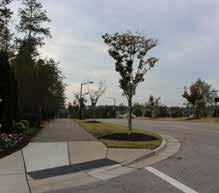
1 minute read
Sidewalks & Multi-Use Paths
Sidewalks and multi-use paths are critical to pedestrian and bicycle connectivity and promote community interaction and active lifestyles. They connect neighborhoods and provide safe routes to shopping areas, schools, and other key destinations. Historically, Wake Forest developed without sidewalks outside the central business district. While the sidewalk and multi-use paths network has grown over recent years, many gaps still exist and there is an opportunity to connect smaller clusters of existing networks. In coordination with the CTP, the Town should continue to expand its sidewalk network to provide a comprehensive and accessible system.
Key Recommendations
| Update the CTP to include an inventory of sidewalks in addition to multi-use paths and establish project priorities, private-public funding, and time frames for closing gaps in the network. | Update the CTP to identify priority areas for high visibility crosswalks, bulb outs, refuge islands, rectangular rapid flashing beacons, and other pedestrian improvements. | Work with Public Works to identify crosswalk ramps that are not ADA compliant and prioritize upgrades. | In coordination with roadway improvements, upgrade aging sidewalks or install new sidewalks if none exist.
| Promote sidewalk, multi-use path, or trail connectivity between residential subdivisions and nonresidential development to improve pedestrian and bicycle connectivity. | Continue to ensure all new residential development provides sidewalks on both sides of the street.
| Encourage multi-use paths to be provided along the main road in developments. | Ensure multifamily and commercial developments include strong pedestrian networks within and between their sites.











